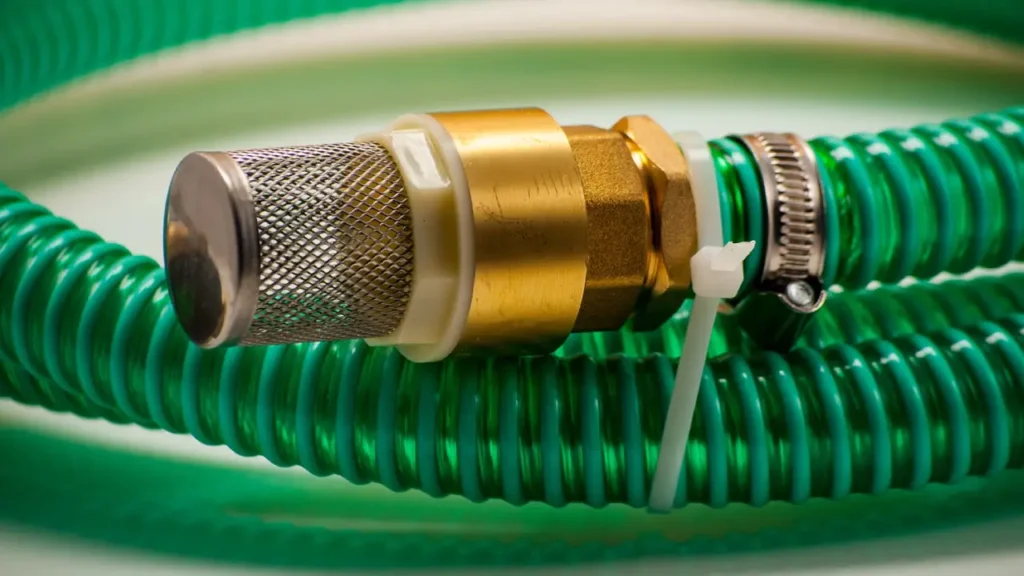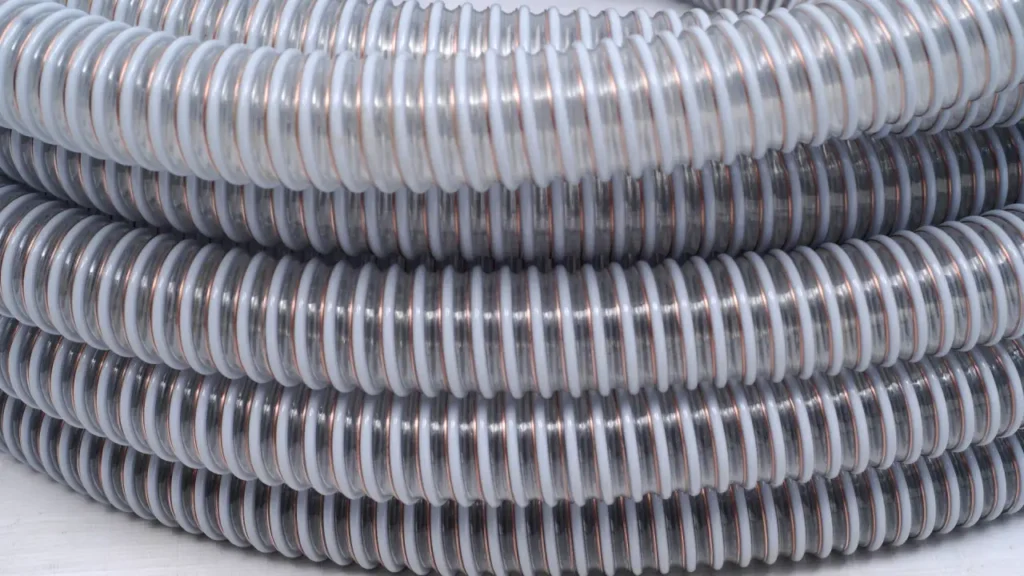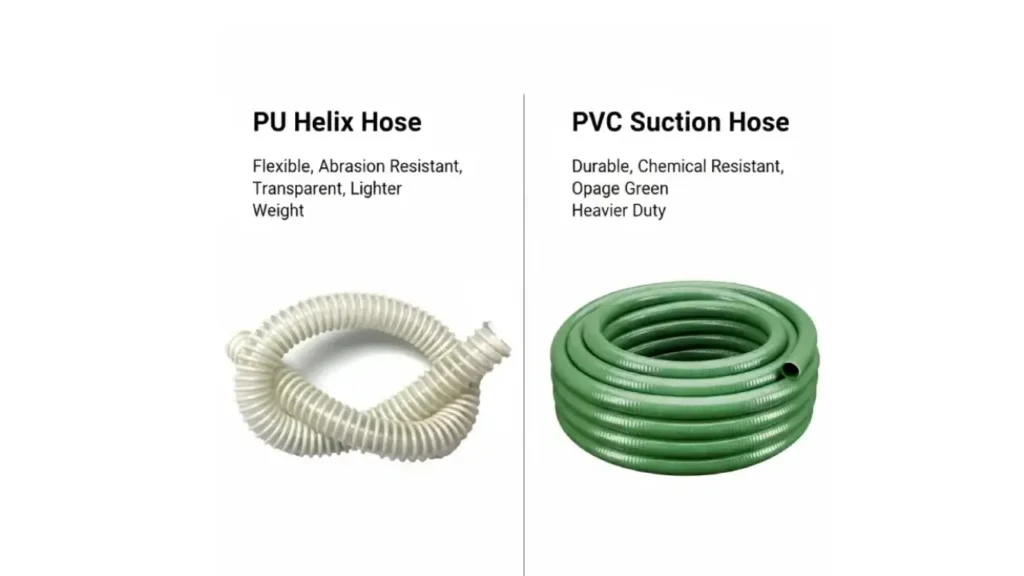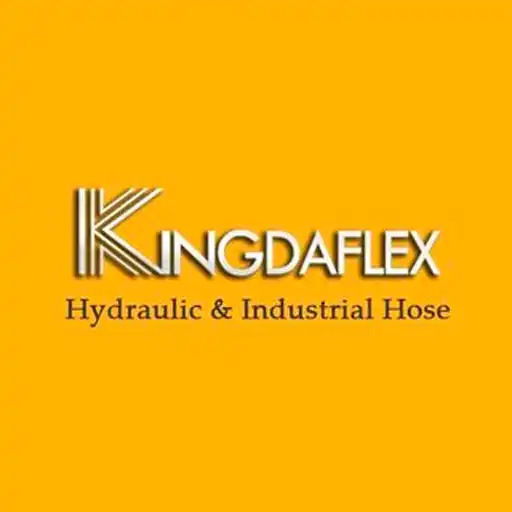When you need a durable hose for industrial applications, two common options are the PU helix and PVC suction hoses. While they may appear similar at first glance, their distinct material compositions give them unique properties, making one more suitable than the other depending on the job. Understanding these differences is key to choosing the right hose.
This guide breaks down the critical distinctions between PU (polyurethane) and PVC (polyvinyl chloride) hoses. We’ll explore how their physical characteristics, like flexibility, abrasion resistance, and chemical compatibility, impact their performance in various environments, ensuring you make an informed decision for your specific needs.
What are Suction Hoses?

Suction hoses are flexible tubes specifically designed to draw or “suck” fluids, gases, or even solids from a source.
Unlike pressure hoses that push materials, suction hoses operate under negative pressure or a vacuum, which allows external atmospheric pressure to push the material into the hose. To prevent them from collapsing under this vacuum, they are typically reinforced with a rigid helix or wire embedded in the hose wall. They are essential for a wide range of applications, including dewatering construction sites, agricultural irrigation, and industrial fluid transfer.
What are PU Helix Suction Hoses?

A PU (polyurethane) helix suction hose is a type of flexible hose made from high-grade polyurethane material, reinforced with a rigid helix, typically made of plastic or steel. The combination of these materials gives it an exceptional balance of flexibility and strength.
The polyurethane wall is known for its remarkable durability and resistance to various elements, making it ideal for tough industrial jobs.
Key characteristics of PU helix suction hoses include:
- Superior Abrasion Resistance: Polyurethane’s unique properties make it highly resistant to wear and tear from abrasive materials like sand, gravel, and sawdust.
- Excellent Flexibility: The material remains flexible even in low temperatures, which is a significant advantage over other plastics that can become stiff and brittle.
- Lightweight: Despite its strength, PU is a lightweight material, making these hoses easier to handle and maneuver on the job site.
- Chemical Resistance: PU hoses offer good resistance to oils, greases, and many chemicals, broadening their application range.
What are PVC Suction Hoses?
A PVC (polyvinyl chloride) suction hose is a type of flexible hose made from PVC, a widely used and affordable plastic polymer. Like other suction hoses, it is reinforced with a rigid helix, often made from the same PVC material, to prevent it from collapsing under vacuum. PVC hoses are a popular choice due to their versatility, low cost, and ease of use in various applications.
Key characteristics of PVC suction hoses include:
- Cost-Effective: PVC is an economical material, making these hoses a budget-friendly option for many applications.
- Good Flexibility: While not as flexible as PU in extreme cold, PVC hoses offer good flexibility for general-purpose use.
- Chemical Resistance: They provide good resistance to water, mild chemicals, and some acids and alkalis.
- Transparency: Many PVC hoses are transparent, which allows for visual inspection of the material flow, a critical feature in some processes.
PU Helix Suction Hoses vs PVC

While both PU helix and PVC suction hoses are used for fluid and material transfer, they differ significantly in their composition, properties, and ideal applications. Understanding these distinctions is crucial for selecting the right hose for your job, ensuring optimal performance and longevity.
Material and Composition
PU (polyurethane) helix suction hoses are crafted from a specialized thermoplastic known for its exceptional durability and flexibility. This material is often combined with a rigid internal helix made of plastic or steel, which provides structural integrity and prevents the hose from collapsing under vacuum. The unique molecular structure of polyurethane gives these hoses their superior physical properties, including resistance to abrasion and impact.
PVC (polyvinyl chloride) suction hoses, on the other hand, are made from a common and cost-effective plastic polymer. The helix in these hoses is typically made from a harder PVC compound, fused to the softer hose wall. This composition makes PVC hoses a practical choice for general-purpose applications where extreme conditions are not a concern. Their simpler chemical structure makes them less durable than their PU counterparts in harsh environments.
Abrasion and Durability
PU hoses are highly celebrated for their superior abrasion resistance, making them the top choice for conveying abrasive materials like grain, gravel, and sawdust. The polyurethane material can withstand constant friction and impact without significant wear and tear, leading to a much longer service life in demanding applications. This durability makes them a cost-effective choice over time, despite a higher initial price.
PVC hoses are less resistant to abrasion and are more prone to wear when used with rough materials. While they are durable enough for water, slurries, and other non-abrasive fluids, their lifespan will be significantly reduced in applications involving abrasive solids. For jobs that require moving harsh or coarse materials, PVC hoses will likely need frequent replacement, increasing long-term operational costs.
Flexibility and Temperature Range
PU hoses maintain their flexibility across a wide temperature range, from extremely low to high temperatures. This makes them ideal for outdoor use in diverse climates, as they won’t become brittle or stiff in cold weather. Their excellent flexibility also makes them easier to handle and install in tight or awkward spaces, reducing physical strain on operators.
PVC hoses, while flexible at room temperature, tend to stiffen significantly in cold conditions. This loss of flexibility can make them difficult to work with and more susceptible to cracking or breaking. They also have a lower maximum operating temperature compared to PU hoses. For applications in cold climates or environments with extreme temperature fluctuations, the limitations of PVC hoses can be a major disadvantage.
Weight and Handling
PU hoses are notably lightweight compared to other hose materials of similar strength. This characteristic is a major advantage for applications requiring frequent movement and setup, such as agricultural irrigation or mobile vacuum systems. Their lighter weight reduces fatigue for the user and makes transportation and storage more convenient.
PVC hoses are generally heavier than PU hoses. While their weight is manageable for many stationary or semi-permanent setups, it can become a disadvantage for jobs that require frequent relocation or extensive manual handling. The added weight can make them more cumbersome and increase the physical effort needed to move them, which can impact productivity over long periods.
Cost and Value
PVC suction hoses have a lower initial purchase cost, making them an attractive option for businesses operating on a tight budget or for applications that are less demanding. Their affordability makes them a popular choice for single-use or short-term projects where durability is not a primary concern.
PU suction hoses have a higher initial price tag, reflecting their superior performance and longevity. However, this higher cost is often offset by their long-term value. Their extended service life, reduced maintenance needs, and ability to handle tougher jobs mean they often provide a better return on investment over time, especially for demanding, industrial applications.
| Aspect | PU Helix Suction Hose | PVC Suction Hose |
| Material | Polyurethane (PU) | Polyvinyl Chloride (PVC) |
| Abrasion Resistance | Excellent | Fair to Good |
| Flexibility | High (maintains flexibility in cold) | Moderate (stiffens in cold) |
| Weight | Lightweight | Heavier |
| Cost | Higher initial cost | Lower initial cost |
| Ideal Use | Abrasive materials, demanding industrial tasks | Water, mild chemicals, general-purpose use |
How to Choose PU Helix and PVC Suction Hoses?
Choosing between a PU helix and a PVC suction hose comes down to a clear understanding of your application’s specific demands.
While PVC hoses are a practical and economical choice for general-purpose tasks like water transfer or light-duty applications, PU hoses are engineered for environments where durability, abrasion resistance, and flexibility are non-negotiable. By evaluating the material being conveyed, the working environment, and your budget, you can make an informed decision that ensures safety and efficiency.
When selecting your hose, consider these factors:
- Type of Material: Are you moving water, or highly abrasive materials like sand, gravel, or wood chips? PU hoses excel at handling abrasive solids, while PVC is better suited for liquids and non-abrasive materials.
- Operating Conditions: Will the hose be exposed to extreme temperatures or constant flexing? PU maintains its flexibility in cold weather and is more resistant to kinking and impact, making it ideal for tough, outdoor jobs.
- Chemical Exposure: Do you need to transfer oils, greases, or specific chemicals? Check the chemical compatibility of both materials with your media, as PU generally offers superior resistance to a wider range of substances.
- Budget: Do you need a low-cost solution for a temporary job, or a long-term investment for a critical process? PVC hoses have a lower initial cost, but PU’s longer service life can save money on replacements and downtime over time.
- Weight and Handling: Will the hose be moved frequently? PU hoses are significantly lighter than PVC, which reduces user fatigue and makes them easier to handle and transport on a job site.
Conclusion
Choosing the right suction hose is crucial for efficiency and longevity. The key takeaway is that PU hoses offer superior durability and abrasion resistance for demanding tasks, while PVC hoses provide a cost-effective solution for lighter-duty applications. Your final choice should be based on a careful assessment of your specific operating conditions, including the materials being conveyed and the environmental factors.
Ultimately, the best hose is the one that meets your specific needs without compromising performance or safety. By understanding the core differences between PU helix and PVC suction hoses, you can avoid common pitfalls and ensure your equipment operates smoothly. This knowledge empowers you to make a smart, long-term investment that pays off in reliable service and reduced maintenance costs.
For all your wholesale suction hose needs, including both PU and PVC options, consider our comprehensive range. At Kingdaflex, we offer high-quality hoses designed to meet diverse industrial demands. Our experts are ready to help you select the ideal hose for your business, ensuring you get the performance and value you expect from a trusted supplier.

